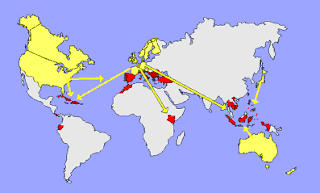Business tourism or business travel is a more limited and focused subset of regular tourism. [1] [2] During business tourism (traveling), individuals are still working and being paid, but are doing so away from both their workplace and home. [2]
Some definitions of tourism exclude business travel. [3] However, the United Nations World Tourism Organization (UNWTO) defines tourists as people "traveling to and staying in places outside their usual environment for not more than one consecutive year for leisure, business and other purposes". [4]
Primary business tourism activities include meetings, and attending conferences and exhibitions. [2] Despite the term business in business tourism, when individuals from government or non-profit organizations engage in similar activities, this is still categorized as business tourism (travel). [2]
Historically, business tourism takes the form of traveling to, spending money and staying abroad, being away for some time, and has a history as long as that of international trade. [5] In late 20th century, business tourism was seen as a major industry. [6]
According to the 1998 data from the British Tourist Authority and London Tourist Board, business tourism accounted for about 14% of all trips to or within the UK, and 15% of the tourist market within the UK. [7] A 2005 estimate suggested that those numbers for UK may be closer to 30%. [8] Sharma (2004) cited a UNWTO estimated that business tourism accounts for 30% of international tourism, through its importance varies significantly between different countries. [5]
Compared to regular tourism, business tourism involves a smaller section of the population, with different motivations, and additional freedom-of-choice-limiting constraints imposed through the business aspects. [1] Destinations of business tourism are much more likely to be areas significantly developed for business purposes (cities, industrial regions, etc.). [1] An average business tourist is more wealthy than an average leisure tourist, and is expected to spend more money. [5]
Business tourism can be divided into primary and secondary activities. Primary ones are business (work)-related, and included activities such as consultancy, inspections, and attending meetings. Secondary ones are related to tourism (leisure) and include activities such as dining out, recreation, shopping, sightseeing, meeting others for leisure activities, and so on. [3] While the primary ones tend to be seen as more important, the secondary ones are nonetheless often described as "substantial". [9]
Business tourism can involve individual and small-group travel, and destinations can include small to larger meetings, including conventions and conferences, trade fairs, and exhibitions. [1] [9] In the US, about half of business tourism involves attending a large meeting of some kind. [9]
Most tourist facilities, such as airports, restaurants and hotels, are shared between leisure and business tourists, through a seasonal difference is often apparent (for example, business tourism may use those facilities during times less attractive for leisure tourists, such as when the weather conditions are less attractive). [2] [8]
Business tourism can be divided into:
The words meetings, incentive, conferences and exhibition in the context of business tourism are abbreviated as MICE. [2]

Tourism is travel for pleasure, and the commercial activity of providing and supporting such travel. UN Tourism defines tourism more generally, in terms which go "beyond the common perception of tourism as being limited to holiday activity only", as people "travelling to and staying in places outside their usual environment for not more than one consecutive year for leisure and not less than 24 hours, business and other purposes". Tourism can be domestic or international, and international tourism has both incoming and outgoing implications on a country's balance of payments.

UN Tourism is a specialized agency of the United Nations which promotes responsible, sustainable and universally accessible tourism. Its headquarters are based in Madrid, Spain. Other offices include: a Regional Support Office for Asia and the Pacific in Nara, Japan and a Regional Office for West Asia in Riyadh, Saudi Arabia.

The Kangla, officially known as the Kangla Fort, is an old fortified palace at Imphal, in the Manipur state of India. It was formerly situated on both sides of the bank of the Imphal River, now remaining only on the western side in ruined conditions. Kangla means "the prominent part of the dry land" in old Meetei. It was the traditional seat of the past Meetei rulers of Manipur.

Sadar Bazaar is the largest wholesale cosmetics jewellery market of household items in Old Delhi, Delhi, India.

Bugyals are alpine pasture lands, or meadows, in higher elevation range between 3,300 metres (10,800 ft) and 4,000 metres (13,000 ft) of the Himalayas in the Indian state of Uttarakhand, where they are called "nature’s own gardens". The topography of the terrain is either flat or sloped. The surface of these bugyals is covered with natural green grass and seasonal flowers. They are used by tribal herdsmen to graze their cattle. During the winter season the alpine meadows remain snow-covered. During summer months, the Bugyals present a riot of beautiful flowers and grass. As bugyals constitute very fragile ecosystems, particular attention needs to be given for their conservation.

Dark tourism has been defined as tourism involving travel to places historically associated with death and tragedy. More recently, it was suggested that the concept should also include reasons tourists visit that site, since the site's attributes alone may not make a visitor a "dark tourist". The main attraction to dark locations is their historical value rather than their associations with death and suffering. Holocaust tourism contains aspects of both dark tourism and heritage tourism.

Tourism geography is the study of travel and tourism, as an industry and as a social and cultural activity. Tourism geography covers a wide range of interests including the environmental impact of tourism, the geographies of tourism and leisure economies, answering tourism industry and management concerns and the sociology of tourism and locations of tourism.

Sustainable tourism is a concept that covers the complete tourism experience, including concern for economic, social, and environmental issues as well as attention to improving tourists' experiences and addressing the needs of host communities. Sustainable tourism should embrace concerns for environmental protection, social equity, and the quality of life, cultural diversity, and a dynamic, viable economy delivering jobs and prosperity for all. It has its roots in sustainable development and there can be some confusion as to what "sustainable tourism" means. There is now broad consensus that tourism should be sustainable. In fact, all forms of tourism have the potential to be sustainable if planned, developed and managed properly. Tourist development organizations are promoting sustainable tourism practices in order to mitigate negative effects caused by the growing impact of tourism, for example its environmental impacts.

Female sex tourism is sex tourism by women who travel intending to engage in sexual activities with one or more locals, including male sex workers and female sex workers. Female sex tourists may seek aspects of the sexual relationship not typically shared by male sex tourists, such as perceived romance and intimacy. The incidence of female sex tourism is much lower than male sex tourism, and the low number of female sex tourists makes it difficult to research this phenomenon, which has been described as "poorly understood".

Tourism is an economic contributor to the Kingdom of Thailand. Estimates of tourism revenue directly contributing to the GDP of 12 trillion baht range from one trillion baht (2013) 2.53 trillion baht (2016), the equivalent of 9% to 17.7% of GDP. When including indirect travel and tourism receipts, the 2014 total is estimated to be the equivalent of 19.3% of Thailand's GDP. The actual contribution of tourism to GDP is lower than these percentages because GDP is measured in value added not revenue. The valued added of the Thailand's tourism industry is not known. According to the secretary-general of the Office of the National Economic and Social Development Council in 2019, the government projects that the tourism sector will account for 30% of GDP by 2030, up from 20% in 2019,Thailand expects to receive 80 million visitors in 2027.

Tourism is a growing sector and key to the economy of several regions of Brazil. The country had 6.589 million visitors in 2018, ranking in terms of the international tourist arrivals as the second main destination in South America after Argentina and third in Latin America after Mexico and Argentina. Revenues from international tourists reached US$5.8 billion in 2015, continuing a recovery trend from the 2008–2009 economic crisis.

Najib Balala is a Kenyan politician who formerly served as the Cabinet Secretary for Tourism. He traces his ancestral origin to the Hadhrami people of Yemen. M.P. for Mvita Constituency. He was the party leader of The Republican Congress Party of Kenya (RC), a partner of the Jubilee Coalition.

Tourism in Costa Rica has been one of the fastest growing economic sectors of the country and by 1995 became the largest foreign exchange earner. Since 1999, tourism has earned more foreign exchange than bananas, pineapples and coffee exports combined. The tourism boom began in 1987, with the number of visitors up from 329,000 in 1988, through 1.03 million in 1999, over 2 million in 2008, to a historical record of 2.66 million foreign visitors in 2015. In 2012, tourism contributed with 12.5% of the country's GDP and it was responsible for 11.7% of direct and indirect employment. In 2009, tourism attracted 17% of foreign direct investment inflows, and 13% in average between 2000 and 2009. In 2010, the tourism industry was responsible for 21.2% of foreign exchange generated by all exports. According to a 2007 report by ECLAC, tourism contributed to a reduction in poverty of 3% in the country.
This is a bibliography of works related the subject of tourism.
Badi Mata/Chamariya Mata is a Hindu goddess of disease, one of a group of seven sister goddesses with similar associations. Chamariya Mata/Badi Mata is doubtless allied to Chamars. Badi Mata is worshipped by some tribes in India, such as the Saharia, Chamar and the Kamar. Her worshippers believe that her wrath causes people to suffer from smallpox. The worshippers sacrifice goats to appease her.

The following outline is provided as an overview of and topical guide to tourism:

International tourism is tourism that crosses national borders. Globalisation has made tourism a popular global leisure activity. The World Tourism Organization defines tourists as people "traveling to and staying in places outside their usual environment for not more than one consecutive year for leisure, business and other purposes". The World Health Organization (WHO) estimates that up to 500,000 people are in flight at any one time.

Overtourism is the congestion or overcrowding from an excess of tourists, resulting in conflicts with locals. The World Tourism Organization (UNWTO) defines overtourism as "the impact of tourism on a destination, or parts thereof, that excessively influences perceived quality of life of citizens and/or quality of visitor experiences in a negative way". This definition shows how overtourism can be observed both among locals, who view tourism as a disruptive factor that increasingly burdens daily life, as well as visitors, who may regard high numbers of tourists as a nuisance.

Zurab Pololikashvili is a Georgian politician and diplomat, currently serving as Secretary-General of the World Tourism Organization. From 2005 to 2009 he was the Deputy Minister of Foreign Affairs of Georgia, and he served as ambassador to Spain, Morocco, Algeria and Andorra.

Tikla, or Tikula, is an archeological site and ancient rock shelter in Madhya Pradesh, India, known for its petroglyphs. Tikla is situated around 170 km (110 mi) south of Mathura and 50 km (31 mi) southwest of Gwalior on the Agra to Mumbai road near the town of Mohana on the right bank of the Parvati river.